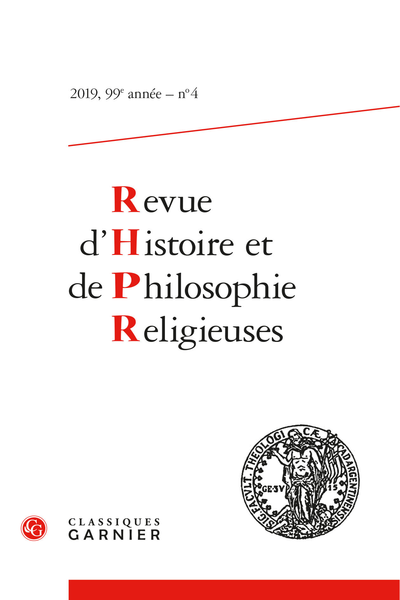
Résumés
- Type de publication : Article de revue
- Revue : Revue d’Histoire et de Philosophie Religieuses
2019 – 4, 99e année, n° 4. varia - Pages : 603 à 604
- Revue : Revue d'Histoire et de Philosophie religieuses
- Thème CLIL : 4046 -- RELIGION -- Christianisme -- Théologie
- EAN : 9782406098942
- ISBN : 978-2-406-09894-2
- ISSN : 2269-479X
- DOI : 10.15122/isbn.978-2-406-09894-2.p.0139
- Éditeur : Classiques Garnier
- Mise en ligne : 10/12/2019
- Périodicité : Trimestrielle
- Langue : Français
Résumés/Abstracts
Michèle Biraud, « Trois hymnes du Corpus hermétique. Leurs structures, leurs rythmes et leur double public »
L’étude des clausules (métriques et accentuelles) en réseaux d’échos dans les trois parties de l’Hymnodie secrète (Corpus hermeticum,xiii, 17-20) montre que c’est une prose eurythmique dans les deux prononciations, ce qui n’est pas exceptionnel à l’époque de la Seconde Sophistique, tandis que l’hymne du Poimandrès (I, 31-32) et la prière de V, 10-11 ne présentent un réel intérêt rythmique qu’en lecture orale moderne. Autant de lectures, autant de fidèles aux compétences culturelles différentes.
Mots-clés : accent, charnière textuelle, clausule accentuelle, clausule métrique, écho rythmique, composition en anneau, eurythmie, gnose, Hymnes hermétiques.
Michèle Biraud, “Three Hymns of the Corpus Hermeticum. Their Structures, their Rhythms and their Double Audience”
The study of metric and accentual clausulae creating networks of echoes in the three parts of the Secret Hymnody (Corpus hermeticum, XIII, 17-20) shows that it is eurythmic prose with both pronunciations, which is not exceptional at the time of the Second Sophistic, while the hymn of Poimandres (I, 31-32) and the prayer of V, 10-11 have a real rhythmic interest only in modern spoken reading. So many readings, so many congregants with different cultural skills.
Keywords: accent, textual hinge, accentual clausula, metric clausula, rhythmic echo, ring-composition, eurythmy, gnosis, Hermetic hymns.
Paul Israël Vazeux, « La controverse des religions politiques et séculières »
Cet article revient sur la controverse des religions politiques et séculières qui a opposé intellectuels français et allemands pendant et après la Deuxième Guerre mondiale et qui continue encore de nourrir le débat philosophique contemporain. Il présente d’abord la formulation conceptuelle du modèle interprétatif des religions politiques et séculières604due à Voegelin et Aron ; puis, il fait droit à la critique virulente qu’Arendt oppose à cette dénomination controversée du phénomène totalitaire.
Mots-clés : religions politiques et séculières, totalitarismes, querelle de la sécularisation, eschatologie judéo-chrétienne, millénarismes, Eric Voegelin, Raymond Aron, Karl Löwith, Hans Blumenberg, Hannah Arendt.
Paul Israël Vazeux, “The Controversy Surrounding Political and Secular Religion”
This article returns to the controversy surrounding political and secular religion which divided French and German thinkers during and after World War II and which continues to animate contemporary philosophical debate. We first offer a conceptual formulation of the interpretative model of political and secular religion following Voegelin and Aron. We then do justice to Arendt’s fierce critique of this controversial species of the phenomenon of totalitarianism.
Keywords: political and secular religions, totalitarianism, secularization quarrel, Judeo-Christian eschatology, millenarianism, Eric Voegelin, Raymond Aron, Karl Löwith, Hans Blumenberg, Hannah Arendt.
Antoine Altieri, « L’art est la manière. L’art comme communion des personnes »
L’article réinterroge, à la suite d’Arthur Danto et de Jean-Marie Schaeffer, l’« essence » de l’art, à travers l’examen phénoménologique de cette banale évidence : l’œuvre artistique est comme telle esthétique. Il s’emploie à montrer qu’il existe une « manière » artistique de jouer avec le « temps vécu ». Ce faisant, il insiste sur une « essence » de l’art comme « communion des vies » et en propose une possible relecture métaphysique, voire théologique.
Mots-clés : expérience esthétique, phénoménologie, communion, art, vie sensible.
Antoine Altieri, “Art is the Way. Art as a Communion of People”
The article re-examines, following Arthur Danto and Jean-Marie Schaeffer, the “essence” of art, through the phenomenological examination of this commonplace evidence: artistic work is in itself aesthetic. We aim to show that there is an artistic “way” to play with “lived time”. In doing so, we insist on an “essence” of art as a “communion of lives” and propose a possible metaphysical, even theological, re-reading of art.
Keywords: aesthetic experience, phenomenology, communion, art, life of the senses.